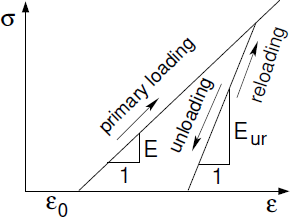Modified Elastic Model
When modeling soils, the assumed linear elastic response is valid for a relatively low magnitude of surcharge and upon unloading we even observe that the elastic strain is rather small compared to the value of the overall strain. The bilinear elastic model allows for taking this observation, to some extent, into account by considering different elastic moduli for loading and unloading.
Reduction in stiffness on the loading path due to evolution of plastic strains is reflected in the definition of the modulus of elasticity E, which can be imagined as a secant modulus pertinent to a certain level of stress. Upon unloading we consider an elastic behavior. The unloading branch is represented in the model by the modulus of unloading/reloading Eur. This model drives the soil response both in unloading and subsequent realoading until arriving at the stress level reached prior to unloading. From this point on, the soil response follows again the modulus of elasticity E.
Graphical representation of the stress-strain law, describing the relationship between strain ε and stress σ, is plotted in the figure, where ε0 = αΔθ represents the initial strain caused in this particular case by the temperature change Δθ only. Upon unloading we may observe evolution of permanent, but not plastic, strains.

Parameters defining the Modified elastic material model are presented in the following table.
Symbol | Units | Description | |
| [MPa] | Modulus of elasticity | |
| [MPa] | Modulus of unloading/reloading | |
| [-] | Poisson's ratio | |
| [kN/m3] | Bulk weight | |
| [-] | Initial void ratio corresponding to the state at the end of 1st calculation stage | |
| [1/K] | Coefficient of thermal expansion (when considering temperature effects) |
A rather indicative value of the modulus of unloading/reloading Eur is about (2-5) times the modulus of elasticity E. In any case, a reliable value of these moduli should be supported by experimental measurements.
Further details can be found in the theoretical manual.